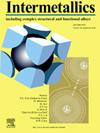NbMoVTa refractory high-entropy alloy incorporated WNi matrix composite as a future plasma-facing material: Evaluation of mechanical properties and helium ion irradiation behavior
IF 4.3
2区 材料科学
Q2 CHEMISTRY, PHYSICAL
引用次数: 0
Abstract
Refractory high-entropy alloys (RHEAs) have gained attention in the last decades with their high mechanical strength, self-healing mechanism, and high irradiation resistance. These materials are evaluated to have a high potential as plasma-facing materials for fusion reactors. In this study, helium ion irradiation and mechanical behaviors of the RHEA-reinforced WNi matrix composites were investigated based on this perspective. Equimolar molybdenum, niobium, tantalum and vanadium powders were mechanically alloyed for 6 h to produce NbMoVTa RHEA with a single BCC phase. Then, different amounts (10, 20, 30, and 40 wt%) of RHEA were added into the W1Ni (containing 99 wt% W and 1 wt% Ni) matrix by planetary ball milling for 72 h. Consolidation was conducted by spark plasma sintering technique (1410 °C, 1 min). X-ray diffraction, scanning electron microscopy coupled with energy dispersion spectroscopy, and Archimedes' density analyses were performed on the composites. Moreover, wear and hardness properties of the composites were examined, and the lowest specific wear rate (0.59 mm3/N.m × 10−5) and the highest hardness value (10.10 GPa) were found for the W1Ni-40RHEA composite. Helium irradiation was exposed to the composites to observe their irradiation resistance. It was observed that the lowest increment and the least deformation were obtained with the SPS'ed W1Ni-40RHEA composite. With the analysis of He+ irradiation, it was determined that the effect of radiation on mechanical properties is irrelevant. Also, it was observed that the addition of RHEA into the W matrix can create a high potential for using plasma-facing material. Moreover, it decreased the problems of tungsten against He+ irradiation.

求助全文
约1分钟内获得全文
求助全文
来源期刊

Intermetallics
工程技术-材料科学:综合
CiteScore
7.80
自引率
9.10%
发文量
291
审稿时长
37 days
期刊介绍:
This journal is a platform for publishing innovative research and overviews for advancing our understanding of the structure, property, and functionality of complex metallic alloys, including intermetallics, metallic glasses, and high entropy alloys.
The journal reports the science and engineering of metallic materials in the following aspects:
Theories and experiments which address the relationship between property and structure in all length scales.
Physical modeling and numerical simulations which provide a comprehensive understanding of experimental observations.
Stimulated methodologies to characterize the structure and chemistry of materials that correlate the properties.
Technological applications resulting from the understanding of property-structure relationship in materials.
Novel and cutting-edge results warranting rapid communication.
The journal also publishes special issues on selected topics and overviews by invitation only.
 求助内容:
求助内容: 应助结果提醒方式:
应助结果提醒方式:


